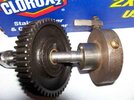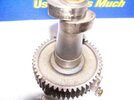I've just finished to rebuilt the engine on my black shadow and I have questions regarding the timing valves, because I'm not sure for the half time pinion dot.
In the Richardson book, Fig 56, when all the marks mesh (cam pinion, idler cam, and half time pinion), the half time pinion should be 4° BTDC for the rear cylinder ? Is that correct ?
Also, when the rear cam pinion mesh whith the idler cam, the inlet valve and the exhaust valve are in balance for the rear cylinder? and the valves for the front cylinder are closed ? Is that correct ?
I just want to make sure that everything is in order.
Thanks for your answers.
In the Richardson book, Fig 56, when all the marks mesh (cam pinion, idler cam, and half time pinion), the half time pinion should be 4° BTDC for the rear cylinder ? Is that correct ?
Also, when the rear cam pinion mesh whith the idler cam, the inlet valve and the exhaust valve are in balance for the rear cylinder? and the valves for the front cylinder are closed ? Is that correct ?
I just want to make sure that everything is in order.
Thanks for your answers.


